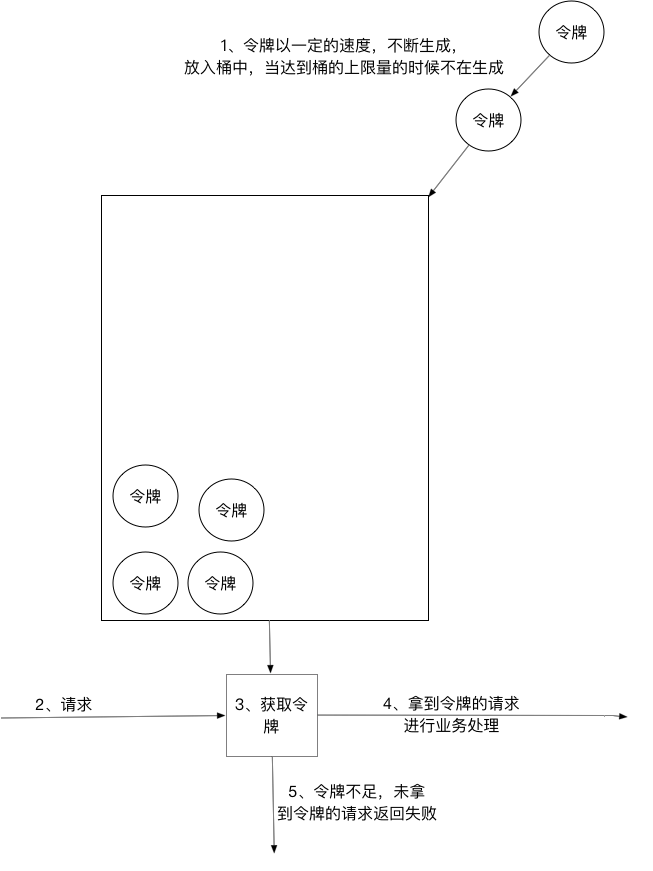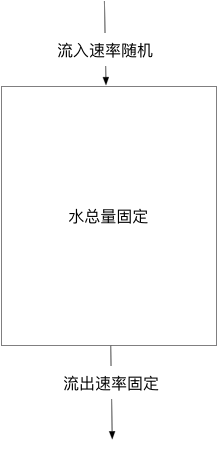转载链接:https://www.cnblogs.com/vveiliang/p/9049393.html
1、令牌桶算法
令牌桶算法是比较常见的限流算法之一,大概描述如下:
1)、所有的请求在处理之前都需要拿到一个可用的令牌才会被处理;
2)、根据限流大小,设置按照一定的速率往桶里添加令牌;
3)、桶设置最大的放置令牌限制,当桶满时、新添加的令牌就被丢弃活着拒绝;
4)、请求达到后首先要获取令牌桶中的令牌,拿着令牌才可以进行其他的业务逻辑,处理完业务逻辑之后,将令牌直接删除;
5)、令牌桶有最低限额,当桶中的令牌达到最低限额的时候,请求处理完之后将不会删除令牌,以此保证足够的限流;

2、漏桶算法
漏桶算法其实很简单,可以粗略的认为就是注水漏水过程,往桶中以一定速率流出水,以任意速率流入水,当水超过桶流量则丢弃,因为桶容量是不变的,保证了整体的速率

C# 代码实现:
using System; using System.Collections.Generic; using System.Threading; using System.Threading.Tasks; namespace 限流算法 { class Program { static void Main(string[] args) { var service = LimitingFactory.Build(LimitingType.LeakageBucket, 500, 200); while (true) { var result = service.Request(); //如果返回true,说明可以进行业务处理,否则需要继续等待 if (result) { //业务处理...... } else Thread.Sleep(1); } Console.WriteLine("Hello World!"); } } public interface ILimitingService : IDisposable { /// <summary> /// 申请流量处理 /// </summary> /// <returns>true:获取成功,false:获取失败</returns> bool Request(); } public class LimitingFactory { /// <summary> /// 创建限流服务对象 /// </summary> /// <param name="limitingType">限流模型</param> /// <param name="maxQPS">最大QPS</param> /// <param name="limitSize">最大可用票据数</param> public static ILimitingService Build(LimitingType limitingType = LimitingType.TokenBucket, int maxQPS = 100, int limitSize = 100) { switch (limitingType) { case LimitingType.TokenBucket: default: return new TokenBucketLimitingService(maxQPS, limitSize); case LimitingType.LeakageBucket: return new LeakageBucketLimitingService(maxQPS, limitSize); } } } /// <summary> /// 限流模式 /// </summary> public enum LimitingType { TokenBucket,//令牌桶模式 LeakageBucket//漏桶模式 } public class LimitedQueue<T> : Queue<T> { private int limit = 0; public const string QueueFulled = "TTP-StreamLimiting-1001"; public int Limit { get { return limit; } set { limit = value; } } public LimitedQueue() : this(0) { } public LimitedQueue(int limit) : base(limit) { this.Limit = limit; } public new bool Enqueue(T item) { if (limit > 0 && this.Count >= this.Limit) { return false; } base.Enqueue(item); return true; } } class TokenBucketLimitingService : ILimitingService { private LimitedQueue<object> limitedQueue = null; private CancellationTokenSource cancelToken; private Task task = null; private int maxTPS; private int limitSize; private object lckObj = new object(); public TokenBucketLimitingService(int maxTPS, int limitSize) { this.limitSize = limitSize; this.maxTPS = maxTPS; if (this.limitSize <= 0) this.limitSize = 100; if (this.maxTPS <= 0) this.maxTPS = 1; limitedQueue = new LimitedQueue<object>(limitSize); for (int i = 0; i < limitSize; i++) { limitedQueue.Enqueue(new object()); } cancelToken = new CancellationTokenSource(); task = Task.Factory.StartNew(new Action(TokenProcess), cancelToken.Token); } /// <summary> /// 定时消息令牌 /// </summary> private void TokenProcess() { int sleep = 1000 / maxTPS; if (sleep == 0) sleep = 1; DateTime start = DateTime.Now; while (cancelToken.Token.IsCancellationRequested == false) { try { lock (lckObj) { limitedQueue.Enqueue(new object()); } } catch { } finally { if (DateTime.Now - start < TimeSpan.FromMilliseconds(sleep)) { int newSleep = sleep - (int)(DateTime.Now - start).TotalMilliseconds; if (newSleep > 1) Thread.Sleep(newSleep - 1); //做一下时间上的补偿 } start = DateTime.Now; } } } public void Dispose() { cancelToken.Cancel(); } /// <summary> /// 请求令牌 /// </summary> /// <returns>true:获取成功,false:获取失败</returns> public bool Request() { if (limitedQueue.Count <= 0) return false; lock (lckObj) { if (limitedQueue.Count <= 0) return false; object data = limitedQueue.Dequeue(); if (data == null) return false; } return true; } } class LeakageBucketLimitingService : ILimitingService { private LimitedQueue<object> limitedQueue = null; private CancellationTokenSource cancelToken; private Task task = null; private int maxTPS; private int limitSize; private object lckObj = new object(); public LeakageBucketLimitingService(int maxTPS, int limitSize) { this.limitSize = limitSize; this.maxTPS = maxTPS; if (this.limitSize <= 0) this.limitSize = 100; if (this.maxTPS <= 0) this.maxTPS = 1; limitedQueue = new LimitedQueue<object>(limitSize); cancelToken = new CancellationTokenSource(); task = Task.Factory.StartNew(new Action(TokenProcess), cancelToken.Token); } private void TokenProcess() { int sleep = 1000 / maxTPS; if (sleep == 0) sleep = 1; DateTime start = DateTime.Now; while (cancelToken.Token.IsCancellationRequested == false) { try { if (limitedQueue.Count > 0) { lock (lckObj) { if (limitedQueue.Count > 0) limitedQueue.Dequeue(); } } } catch { } finally { if (DateTime.Now - start < TimeSpan.FromMilliseconds(sleep)) { int newSleep = sleep - (int)(DateTime.Now - start).TotalMilliseconds; if (newSleep > 1) Thread.Sleep(newSleep - 1); //做一下时间上的补偿 } start = DateTime.Now; } } } public void Dispose() { cancelToken.Cancel(); } public bool Request() { if (limitedQueue.Count >= limitSize) return false; lock (lckObj) { if (limitedQueue.Count >= limitSize) return false; return limitedQueue.Enqueue(new object()); } } } }
漏桶算法 VS 令牌桶算法
漏桶算法和令牌桶算法最明显的区别是令牌桶算法允许流量一定程度的突发。因为默认的令牌桶算法,取走token是不需要耗费时间的,也就是说,假设桶内有100个token时,那么可以瞬间允许100个请求通过。
令牌桶算法由于实现简单,且允许某些流量的突发,对用户友好,所以被业界采用地较多。当然我们需要具体情况具体分析,只有最合适的算法,没有最优的算法。